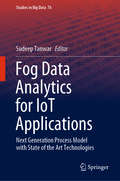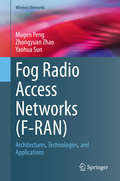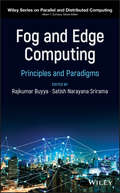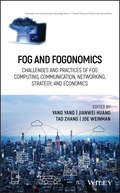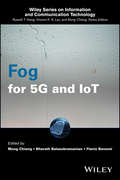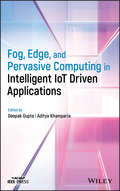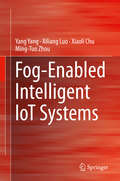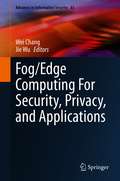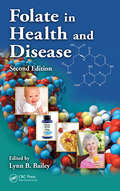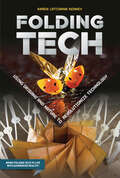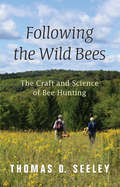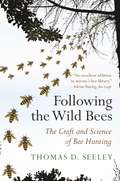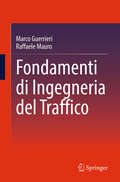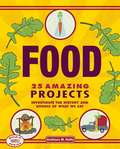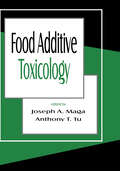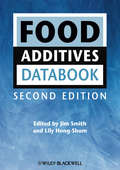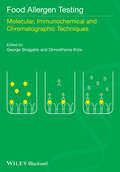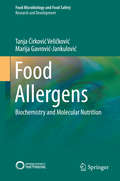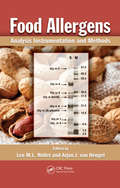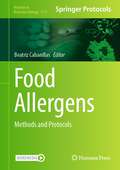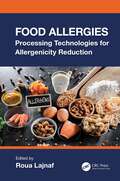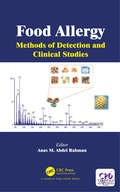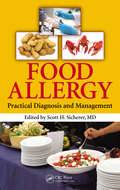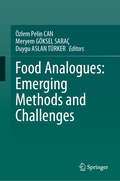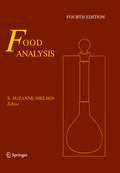- Table View
- List View
Fog Data Analytics for IoT Applications: Next Generation Process Model with State of the Art Technologies (Studies in Big Data #76)
by Sudeep TanwarThis book discusses the unique nature and complexity of fog data analytics (FDA) and develops a comprehensive taxonomy abstracted into a process model. The exponential increase in sensors and smart gadgets (collectively referred as smart devices or Internet of things (IoT) devices) has generated significant amount of heterogeneous and multimodal data, known as big data. To deal with this big data, we require efficient and effective solutions, such as data mining, data analytics and reduction to be deployed at the edge of fog devices on a cloud. Current research and development efforts generally focus on big data analytics and overlook the difficulty of facilitating fog data analytics (FDA). This book presents a model that addresses various research challenges, such as accessibility, scalability, fog nodes communication, nodal collaboration, heterogeneity, reliability, and quality of service (QoS) requirements, and includes case studies demonstrating its implementation. Focusing on FDA in IoT and requirements related to Industry 4.0, it also covers all aspects required to manage the complexity of FDA for IoT applications and also develops a comprehensive taxonomy.
Fog Radio Access Networks: Architectures, Technologies, and Applications (Wireless Networks)
by Mugen Peng Zhongyuan Zhao Yaohua SunThis book provides a comprehensive introduction of Fog Radio Access Networks (F-RANs), from both academic and industry perspectives. The authors first introduce the network architecture and the frameworks of network management and resource allocation for F-RANs. They then discuss the recent academic research achievements of F-RANs, such as the analytical results of theoretical performance limits and optimization theory-based resource allocation techniques. Meanwhile, they discuss the application and implementations of F-RANs, including the latest standardization procedure, and the prototype and test bed design. The book is concluded by summarizing the existing open issues and future trends of F-RANs. Includes the latest theoretical and technological research achievements of F-RANs, also discussing existing open issues and future trends of F-RANs toward 6G from an interdisciplinary perspective; Provides commonly-used tools for research and development of F-RANs such as open resource projects for implementing prototypes and test beds;Includes examples of prototype and test bed design and gives tools to evaluate the performance of F-RANs in simulations and experimental circumstances.
Fog and Edge Computing: Principles and Paradigms (Wiley Series on Parallel and Distributed Computing)
by Rajkumar Buyya Satish Narayana SriramaA comprehensive guide to Fog and Edge applications, architectures, and technologies Recent years have seen the explosive growth of the Internet of Things (IoT): the internet-connected network of devices that includes everything from personal electronics and home appliances to automobiles and industrial machinery. Responding to the ever-increasing bandwidth demands of the IoT, Fog and Edge computing concepts have developed to collect, analyze, and process data more efficiently than traditional cloud architecture. Fog and Edge Computing: Principles and Paradigms provides a comprehensive overview of the state-of-the-art applications and architectures driving this dynamic field of computing while highlighting potential research directions and emerging technologies. Exploring topics such as developing scalable architectures, moving from closed systems to open systems, and ethical issues rising from data sensing, this timely book addresses both the challenges and opportunities that Fog and Edge computing presents. Contributions from leading IoT experts discuss federating Edge resources, middleware design issues, data management and predictive analysis, smart transportation and surveillance applications, and more. A coordinated and integrated presentation of topics helps readers gain thorough knowledge of the foundations, applications, and issues that are central to Fog and Edge computing. This valuable resource: Provides insights on transitioning from current Cloud-centric and 4G/5G wireless environments to Fog Computing Examines methods to optimize virtualized, pooled, and shared resources Identifies potential technical challenges and offers suggestions for possible solutions Discusses major components of Fog and Edge computing architectures such as middleware, interaction protocols, and autonomic management Includes access to a website portal for advanced online resources Fog and Edge Computing: Principles and Paradigms is an essential source of up-to-date information for systems architects, developers, researchers, and advanced undergraduate and graduate students in fields of computer science and engineering.
Fog and Fogonomics: Challenges and Practices of Fog Computing, Communication, Networking, Strategy, and Economics (Information and Communication Technology Series, #57)
by Yang Yang Joe Weinman Tao Zhang Jianwei HuangTHE ONE-STOP RESOURCE FOR ANY INDIVIDUAL OR ORGANIZATION CONSIDERING FOG COMPUTING Fog and Fogonomics is a comprehensive and technology-centric resource that highlights the system model, architectures, building blocks, and IEEE standards for fog computing platforms and solutions. The "fog" is defined as the multiple interconnected layers of computing along the continuum from cloud to endpoints such as user devices and things including racks or microcells in server closets, residential gateways, factory control systems, and more. The authors—noted experts on the topic—review business models and metrics that allow for the economic assessment of fog-based information communication technology (ICT) resources, especially mobile resources. The book contains a wide range of templates and formulas for calculating quality-of-service values. Comprehensive in scope, it covers topics including fog computing technologies and reference architecture, fog-related standards and markets, fog-enabled applications and services, fog economics (fogonomics), and strategy. This important resource: Offers a comprehensive text on fog computing Discusses pricing, service level agreements, service delivery, and consumption of fog computing Examines how fog has the potential to change the information and communication technology industry in the next decade Describes how fog enables new business models, strategies, and competitive differentiation, as with ecosystems of connected and smart digital products and services Includes case studies featuring integration of fog computing, communication, and networking systems Written for product and systems engineers and designers, as well as for faculty and students, Fog and Fogonomics is an essential book that explores the technological and economic issues associated with fog computing.
Fog for 5G and IoT
by Mung Chiang Bharath Balasubramanian Flavio BonomiThe book examines how Fog will change the information technology industry in the next decade. Fog distributes the services of computation, communication, control and storage closer to the edge, access and users. As a computing and networking architecture, Fog enables key applications in wireless 5G, the Internet of Things, and big data. The authors cover the fundamental tradeoffs to major applications of fog. The book chapters are designed to motivate a transition from the current cloud architectures to the Fog (Chapter 1), and the necessary architectural components to support such a transition (Chapters 2-6). The rest of the book (Chapters 7-xxx) are dedicated to reviewing the various 5G and IoT applications that will benefit from Fog networking. This volume is edited by pioneers in Fog and includes contributions by active researchers in the field. Covers fog technologies and describes the interaction between fog and cloud Presents a view of fog and IoT (encompassing ubiquitous computing) that combines the aspects of both industry and academia Discusses the various architectural and design challenges in coordinating the interactions between M2M, D2D and fog technologies “Fog for 5G and IoT” serves as an introduction to the evolving Fog architecture, compiling work from different areas that collectively form this paradigm Mung Chiang is the Arthur LeGrand Doty Professor of Electrical Engineering at Princeton University, the Director of the Keller Center for Innovations in Engineering Education, and the Chair of Princeton Entrepreneurship Advisory Committee. Dr. Chiang founded the Princeton EDGE Lab in 2009, which bridges the theory-practice gap in edge networking research by spanning from proofs to prototypes. He is the recipient of the 2013 Alan T. Waterman Award. Bharath Balasubramanian is a distributed systems researcher in the Cloud Software Research department at ATT Labs. Prior to this, he had a postdoc in the Electrical Engineering department at Princeton University working with Mung Chiang in the EDGE lab. Flavio Bonomi is a Cisco Fellow, Vice President, and is the Head of the Advanced Architecture and Research Organization at Cisco Systems.
Fog, Edge, and Pervasive Computing in Intelligent IoT Driven Applications
by Deepak GuptaA practical guide to the design, implementation, evaluation, and deployment of emerging technologies for intelligent IoT applications With the rapid development in artificially intelligent and hybrid technologies, IoT, edge, fog-driven, and pervasive computing techniques are becoming important parts of our daily lives. This book focuses on recent advances, roles, and benefits of these technologies, describing the latest intelligent systems from a practical point of view. Fog, Edge, and Pervasive Computing in Intelligent IoT Driven Applications is also valuable for engineers and professionals trying to solve practical, economic, or technical problems. With a uniquely practical approach spanning multiple fields of interest, contributors cover theory, applications, and design methodologies for intelligent systems. These technologies are rapidly transforming engineering, industry, and agriculture by enabling real-time processing of data via computational, resource-oriented metaheuristics and machine learning algorithms. As edge/fog computing and associated technologies are implemented far and wide, we are now able to solve previously intractable problems. With chapters contributed by experts in the field, this book: Describes Machine Learning frameworks and algorithms for edge, fog, and pervasive computing Considers probabilistic storage systems and proven optimization techniques for intelligent IoT Covers 5G edge network slicing and virtual network systems that utilize new networking capacity Explores resource provisioning and bandwidth allocation for edge, fog, and pervasive mobile applications Presents emerging applications of intelligent IoT, including smart farming, factory automation, marketing automation, medical diagnosis, and more Researchers, graduate students, and practitioners working in the intelligent systems domain will appreciate this book’s practical orientation and comprehensive coverage. Intelligent IoT is revolutionizing every industry and field today, and Fog, Edge, and Pervasive Computing in Intelligent IoT Driven Applications provides the background, orientation, and inspiration needed to begin.
Fog-Enabled Intelligent IoT Systems
by Xiaoli Chu Yang Yang Xiliang Luo Ming-Tuo ZhouThis book first provides a comprehensive review of state-of-the-art IoT technologies and applications in different industrial sectors and public services. The authors give in-depth analyses of fog computing architecture and key technologies that fulfill the challenging requirements of enabling computing services anywhere along the cloud-to-thing continuum. Further, in order to make IoT systems more intelligent and more efficient, a fog-enabled service architecture is proposed to address the latency requirements, bandwidth limitations, and computing power issues in realistic cross-domain application scenarios with limited priori domain knowledge, i.e. physical laws, system statuses, operation principles and execution rules. Based on this fog-enabled architecture, a series of data-driven self-learning applications in different industrial sectors and public services are investigated and discussed, such as robot SLAM and formation control, wireless network self-optimization, intelligent transportation system, smart home and user behavior recognition. Finally, the advantages and future directions of fog-enabled intelligent IoT systems are summarized. Provides a comprehensive review of state-of-the-art IoT technologies and applications in different industrial sectors and public servicesPresents a fog-enabled service architecture with detailed technical approaches for realistic cross-domain application scenarios with limited prior domain knowledgeOutlines a series of data-driven self-learning applications (with new algorithms) in different industrial sectors and public services
Fog/Edge Computing For Security, Privacy, and Applications (Advances in Information Security #83)
by Jie Wu Wei ChangThis book provides the state-of-the-art development on security and privacy for fog/edge computing, together with their system architectural support and applications. This book is organized into five parts with a total of 15 chapters. Each area corresponds to an important snapshot. The first part of this book presents an overview of fog/edge computing, focusing on its relationship with cloud technology and the future with the use of 5G communication. Several applications of edge computing are discussed. The second part of this book considers several security issues in fog/edge computing, including the secure storage and search services, collaborative intrusion detection method on IoT-fog computing, and the feasibility of deploying Byzantine agreement protocols in untrusted environments. The third part of this book studies the privacy issues in fog/edge computing. It first investigates the unique privacy challenges in fog/edge computing, and then discusses a privacy-preserving framework for the edge-based video analysis, a popular machine learning application on fog/edge. This book also covers the security architectural design of fog/edge computing, including a comprehensive overview of vulnerabilities in fog/edge computing within multiple architectural levels, the security and intelligent management, the implementation of network-function-virtualization-enabled multicasting in part four. It explains how to use the blockchain to realize security services. The last part of this book surveys applications of fog/edge computing, including the fog/edge computing in Industrial IoT, edge-based augmented reality, data streaming in fog/edge computing, and the blockchain-based application for edge-IoT. This book is designed for academics, researchers and government officials, working in the field of fog/edge computing and cloud computing. Practitioners, and business organizations (e.g., executives, system designers, and marketing professionals), who conduct teaching, research, decision making, and designing fog/edge technology will also benefit from this book The content of this book will be particularly useful for advanced-level students studying computer science, computer technology, and information systems, but also applies to students in business, education, and economics, who would benefit from the information, models, and case studies therein.
Folate in Health and Disease
by Lynn B. BaileyDuring the fifteen years since the bestselling first edition of Folate in Health and Disease was published, there have been thousands of new research studies related to folate and its role in health and disease. The second edition of the book uniquely bridges the gap between basic science and public health/clinical medicine.Presents Groundbreaking
Folding Tech: Using Origami and Nature to Revolutionize Technology
by Karen Latchana KenneySpace probes, self-assembling robots, crash-absorbing cars, and designer proteins all have one thing in common: their use of folding technologies. To develop these technologies, engineers are taking inspiration from an unusual source—origami, the ancient art of paper folding. Examine origami's origins, how it intersects with mathematics, and how it became a tool to solve some of the most complicated challenges in engineering, architecture, technology, and medicine today. Plus, get a close-up look at these technologies with two augmented reality images included in the book!
Following the Wild Bees: The Craft and Science of Bee Hunting
by Thomas D. SeeleyFollowing the Wild Bees is a delightful foray into the pastime of bee hunting, an exhilarating outdoor activity that used to be practiced widely but which few people know about today. Thomas Seeley, a world authority on honey bees, vividly describes the history and science behind this lost pastime and how anyone can do it. Following the Wild Bees is both a unique meditation on the pleasures of the natural world and a guide to the ingenious methods that compose the craft of the bee hunter.Seeley explains how one finds a patch of flowers humming with honey bees, captures and sumptuously feeds the bees, and then releases and follows them, step-by-step in whatever direction they fly, back to their secret residence in a hollow tree, old building, or abandoned hive. The bee hunter's reward is a thrilling encounter with nature that challenges mind and body while also giving new insights into the remarkable behavior of honey bees living in the wild.Drawing on decades of experience as a bee hunter and bee biologist, Seeley weaves informative discussions of the biology of wild honey bees with colorful historical anecdotes, personal insights, and beautiful photos. Whether you're a bee enthusiast or just curious about the natural world, Following the Wild Bees is the ideal companion for newcomers to bee hunting and a rare treat for armchair naturalists.
Following the Wild Bees: The Craft and Science of Bee Hunting
by Thomas D. SeeleyA how-to book on an exhilarating outdoor activity and a unique meditation on the pleasures of the natural worldFollowing the Wild Bees is a delightful foray into the pastime of bee hunting, an exhilarating outdoor activity that used to be practiced widely but which few people know about today. Weaving informative discussions of bee biology with colorful anecdotes, personal insights, and beautiful photos, Thomas Seeley describes the history and science behind this lost pastime and how anyone can do it. The bee hunter’s reward is a thrilling encounter with nature that challenges mind and body while also giving insights into the remarkable behavior of honey bees living in the wild. Whether you’re a bee enthusiast or just curious about the natural world, this book is the ideal companion for newcomers to bee hunting and a rare treat for armchair naturalists.
Fondamenti di Ingegneria del Traffico
by Raffaele Mauro Marco GuerrieriQuesto libro tratta una selezione di argomenti fondamentali dell'ingegneria del traffico utili per la progettazione e il controllo delle strutture autostradali. La trattazione è concisa, ma non trascura di esaminare gli aspetti teorici più recenti e cruciali che sono alla base di numerose applicazioni dell'ingegneria autostradale, come, ad esempio, gli aspetti essenziali del calcolo dell'affidabilità dei flussi di traffico autostradale e del controllo automatizzato dei sistemi autostradali. Per rendere questi argomenti più facili da seguire, vengono forniti numerosi esempi di applicazioni lavorative, che vengono illustrate in modo molto dettagliato. In tutti i contenuti è stato adottato uno stile intuitivo e discorsivo, piuttosto che formale.Il libro offre quindi conoscenze pratiche e aggiornate su diversi aspetti dell'ingegneria del traffico, che interessano un ampio pubblico di studenti, ricercatori, pianificatori dei trasporti, specialisti del trasporto pubblico, urbanisti e decisori.
Food
by Farah Rizvi Kathleen M. ReillyFrom the minute life begins, food makes you strong, helps you grow, and gives you energy. But do you take that ham sandwich for granted? You might not give a lot of thought to where your food comes from, how it got to you, what's really in it, or what it does for you. Food: 25 Amazing Projects Investigate the History and Science of What We Eat gives kids some "food for thought" as they dive into exciting projects about the incredible world of food. Kids will have fun learning about all aspects of food in our daily lives-how vegetarians balance their diet, how some cultures rose and fell based on a single food source, the route from farm to market, how eating locally makes an impact, and much more.
Food Additive Toxicology
by Joseph A. Maga Anthony Y. Tu"Provides both historical information and the latest toxicological data on various classes of food additives--examining the production, application, and safety of numerous compounds used to enhance and preserve the quality of foods."
Food Additives Data Book
by Jim Smith Lily Hong-ShumThe use of additives in food is a dynamic one, as consumers demand fewer additives in foods and as governments review the list of additives approved and their permitted levels. Scientists also refine the knowledge of the risk assessment process as well as improve analytical methods and the use of alternative additives, processes or ingredients. Since the first edition of the Food Additives Databook was published, there have been numerous changes due to these developments and some additives are no longer permitted, some have new permitted levels of use and new additives have been assessed and approved. The revised second edition of this major reference work covers all the "must-have" technical data on food additives. Compiled by food industry experts with a proven track record of producing high quality reference work, this volume is the definitive resource for technologists in small, medium and large companies, and for workers in research, government and academic institutions. Coverage is of Preservatives, Enzymes, Gases, Nutritive additives, Emulsifiers, Flour additives, Acidulants, Sequestrants, Antioxidants, Flavour enhancers, Colour, Sweeteners, Polysaccharides, Solvents. Entries include information on: Function and Applications, Safety issues, International legal issues, Alternatives, Synonyms, Molecular Formula and mass, Alternative forms, Appearance, Boiling, melting, and flash points, density, purity, water content, solubility, Synergists, Antagonists, and more with full and easy-to-follow-up references. Reviews of the first edition: "Additives have their advantages for the food industry in order to provide safe and convenient food products. It is therefore essential that as much information as possible is available to allow an informed decision on the selection of an additive for a particular purpose. This data book provides such information - consisting of over 1000 pages and covering around 350 additives. This data book does provide a vast amount of information; it is what it claims to be! Overall, this is a very useful publication and a good reference book for anyone working in the food and dairy industry." —International Journal of Dairy Technology, Volume 59 Issue 2, May 2006 "This book is the best I have ever seen ... a clear winner over all other food additive books .... a superb edition." —SAAFOST (South African Association for Food Science and Technology)
Food Allergen Testing: Molecular, Immunochemical and Chromatographic Techniques
by Dimosthenis Kizis George SiragakisAn in-depth review of the current scientific knowledge on food allergens testing, covering the major methodologies and techniques used to detect food allergens. Food allergens are a series of agents, mainly proteins, which cause various unpleasant and sometimes clinical symptoms in humans through consumption of foods. Perhaps surprisingly, there are no treatments against food allergies which have been found to be 100% effective. The scope for individual difference in terms of how a person reacts to a given allergen is massive, making it incredibly difficult and complex to try and medicate against allergies. Food Allergens Testing takes a thorough look at modern molecular biology and immunochemical techniques used to detect food allergens. The eleven chapters constitute an in-depth review of the current scientific knowledge on food allergens, covering the major methodologies and techniques used in validated analytical approaches. The book is aimed at scientists and technical staff in the food industry and analytical laboratories who need an up-to-date treatment of both fundamental and applied research goals on food allergens, as well as a report on the validated methods currently in use for food allergens testing.
Food Allergens
by Tanja Ćirković Veličković Marija Gavrović-JankulovićA food allergen has the ability to first elicit an IgE response, and then, on subsequent exposures, a clinical response to the same or similar protein. How harmless food protein becomes recognized by the mucosal immune system as an allergen remains an open question and more data are needed to explain how regulatory mechanisms of the mucosal immune system fail and result in allergic sensitization to dietary antigens. Some biochemical characteristics associated with food allergens, such as the presence of multiple, linear IgE-binding epitopes and the resistance of the protein to digestion and processing, seem to predominate among food allergens. Digestion susceptibility of food allergens that sensitize via the gastrointestinal tract and stability to food processing conditions are inherently related to protein structural features. Thereby, physiological changes in the digestion process, pathological conditions affecting digestion, as well as procedures and food processing conditions that affect protein structure may all have a profound effect on the sensitizing potential and allergenicity of food proteins. In addition, signals coming from the diet and micro biome can modulate regulatory mechanisms of the mucosal immune system and influence mucosal immunity and intestinal barrier function. The detection of allergenic ingredients in food products has received increased attention from the food industry and legislative and regulatory agencies over recent years. This has resulted in the improvement of applied safety measures that provide protection for food-allergic consumers and development of sensitive and highly specific analytical methods of food allergens detection. Food allergy is an important and common health issue and therefore there is a need to characterize the sensitizing potential of newly introduced proteins in genetically engineered foods. A combination of in vitro and in silico methods provide information that contributes to safety assessment. Suitable in vivo models may provide a more holistic assessment of allergenic potential of novel food proteins.
Food Allergens: Analysis Instrumentation and Methods
by Leo M.L. Nollet Arjon J. van HengelWhile there are many books about various aspects of food allergy and allergens, not many comprehensively review the wide range of instrumentation and methods used in this analysis. Covering all of the major recognized food allergens in the US and EU, Food Allergens: Analysis Instrumentation and Methods begins with an introduction to the problem and
Food Allergens: Methods and Protocols (Methods in Molecular Biology #2717)
by Beatriz CabanillasThis detailed volume provides a comprehensive collection of methods and protocols in food allergy and food allergens studies. The selected protocols explore the study of food allergens, from recombinant production, purification procedures, IgE and T cell epitopes characterization, to allergen structure description, cellular responses, and tolerance induction, through a variety of techniques and animal models. Written for the highly successful Methods in Molecular Biology series, chapters include introductions to their respective topics, lists of the necessary materials and reagents, step-by-step and readily reproducible laboratory protocols, as well as tips on troubleshooting and avoiding known pitfalls. Authoritative and practical, Food Allergens: Methods and Protocols serves as an ideal reference for scientists at all stages involved in the study of food allergy and allergenic components.
Food Allergies: Processing Technologies for Allergenicity Reduction
by Roua LajnafMuch has been written about food allergies in scientific journals and in the lay press, but Food Allergies: Processing Technologies for Allergenicity Reduction approaches the issue of food allergies from an industrial processing rather than a clinical perspective.Indeed, industrial food processing technologies can have many beneficial effects to obtain various food products and to preserve foods from physical, chemical and microbiological alterations. However, processing technologies, including thermal and non‑thermal technologies, can also alter the allergenic properties of food proteins.This book provides an authoritative source of information on the relationship between food processing technologies and food allergens with a greater variety of studied allergens including peanuts, tree nuts, cow’s milk, eggs, sesame, lupine, soy, wheat, mustard, mushroom, fish and shellfish, as well as the importance of processing these when producing hypoallergenic foods.Key Features: Presents food allergies with recent advances and statistics concerning prevalence, physiopathologic mechanism, diagnosis and anaphylaxis Discusses food allergies in the food industry and investigates the effect of processing on allergenicity of foods during manufacturing Provides food processing and promising technologies to produce hypoallergenic food with high quality Covers the allergenic effect of different food additives with an investigation of cross‑reaction risks This unique book is an indispensable guide for allergic patients, production managers, scientists and nutritionists within the food industry as well as covering a range of critical topics in this area for all those concerned with understanding and managing food allergies.
Food Allergy: Methods of Detection and Clinical Studies
by Anas RahmanThis book explores the recent advances and integrations in molecular technology in food research platforms, which have revolutionized the way we discover and trace potential allergens in our food and drugs and how we utilize that for diagnosis and management. These different technologies for global allergenomic profiling in different kinds of food are discussed, including mass spectrometry, chromatography, and nuclear magnetic resonance. The book also addresses multiomics research with bioinformatics strategies in food allergy in terms of allergen characterization and quantitation, and covers applications in food allergy research from discovery to routine analysis.
Food Allergy: Practical Diagnosis and Management
by Scott H. SichererFood allergy has increased over the past two decades, with a larger number of patients presenting a myriad of related symptoms and illnesses to physicians and allied health professionals. The growing number of patients poses a challenge to health care providers and confirms the need for developing best clinical practice guidelines. Based on the Exp
Food Analogues: Emerging Methods and Challenges
by Özlem Pelin Can Meryem Göksel Saraç Duygu Aslan TürkerAs vegetarian and vegan diets have taken hold across the Western world in recent years, the food industry has in turn seen a burgeoning demand for plant-based substitutes, known as analogues. Consumers are hungry for a product that aligns with their values, meets their nutritional needs, and also delivers on its promise of simulating the qualities of its target food item, be that beef, chicken, egg or dairy. Researchers are thus continually working to more closely approximate not only the taste but also the aesthetic, textural and rheological properties of the food item they are imitating. Meanwhile, questions about the nutritional content and environmental impact of food analogues are also of major interest for conscious consumers. While existing volumes have covered specific analogues such as meat or dairy, Food Analogues: Emerging Methods and Challenges will be the first to offer an authoritative overview of all food analogues and comprehensively assess the current and future state of the industry. This text covers both the fundamental processes of textural manipulation and sensory evaluation as well as the microbiological and regulatory aspects of these plant-based substitutes. Looking towards the future of food analogue technology, it will also discuss promising new approaches such as the use of 3D printing and edible insects in analogue production. This book will be of value to researchers, manufacturers, regulators, nutritionists, and even consumers themselves, seeking to make more informed decisions about their diets.
Food Analysis
by S. Suzanne NielsenThis book provides information on the techniques needed to analyze foods in laboratory experiments. All topics covered include information on the basic principles, procedures, advantages, limitations, and applications. This book is ideal for undergraduate courses in food analysis and is also an invaluable reference to professionals in the food industry. General information is provided on regulations, standards, labeling, sampling and data handling as background for chapters on specific methods to determine the chemical composition and characteristics of foods. Large, expanded sections on spectroscopy and chromatography also are included. Other methods and instrumentation such as thermal analysis, ion-selective electrodes, enzymes, and immunoassays are covered from the perspective of their use in the analysis of foods. A website with related teaching materials is accessible to instructors who adopt the textbook.
